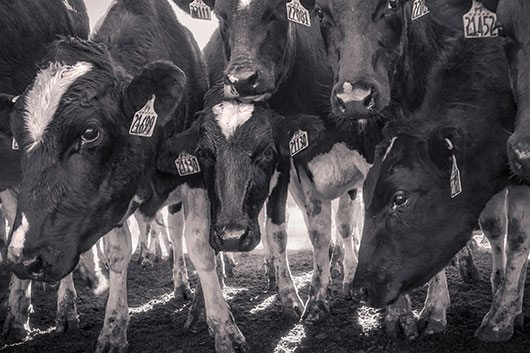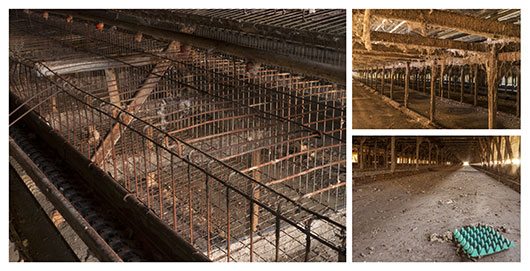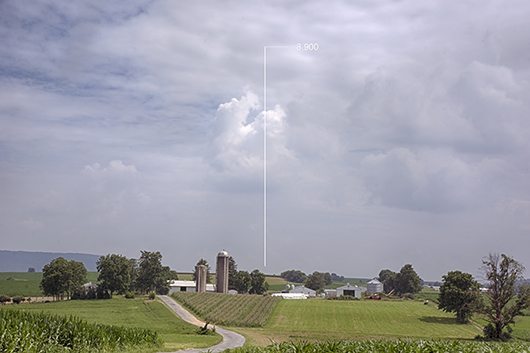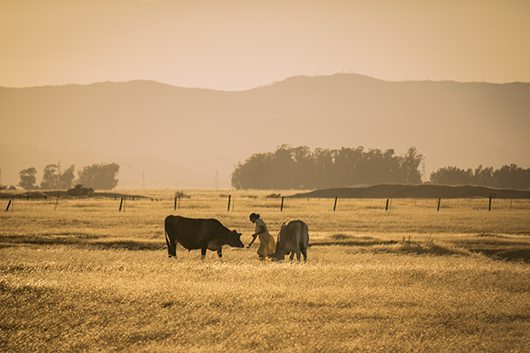I. ESSENTIAL CONNECTIONS
IN MY DARKEST HOURS, my most debilitating fear has been that we are alone in an indifferent universe, that beauty, empathy, love are nothing but human strutting and fretting, just sound and fury in a tale told by an idiot, signifying nothing.[1] Could these virtues be just a social construct, another human invention that feeds a delusion that our existence is not meaningless or futile? I suppose that religion provides reassurance for some. But I cannot take it on faith that these qualities are real, that they exist beyond human social constructs, that we are not alone. I need evidence.
Non-human animals recognize beauty, protect their young, and exhibit empathy. We have a word for this: love. This is our most meaningful experience and connects humans to all sentient life, evidence that we are not alone.
So you see, I am deeply concerned for all sentient animals, with whom I am most essentially connected.
Oceans, forests, rivers, land, and air are now so besieged and polluted that they are becoming unable to sustain life. Entire species are dying at alarming rates. We are in the midst of the sixth mass extinction, this one caused by human activity. The environmental cataclysm we have ignited is unleashing hurricanes, tsunamis, floods, droughts, and wildfires. Climate change directly contributes to increased poverty, hunger, disease, and global conflict.
Environmentalists have fought courageously against the fossil fuel industry. But the movement has largely ignored animal agriculture, which is responsible for 18% to 51% of greenhouse gases, more than all the transportation in the world.[2] Animal agriculture is a leading cause, if not the leading cause, of deforestation, ocean acidification, habitat destruction, loss of biodiversity, and mass species extinction. The lesson here is clear; if we are to restore health to the earth, we must learn to live in harmony with all beings with whom we share our home.
Ecofeminist scholar Marti Kheel writes: ‘Ecofeminism examines and critiques the historical and mutually reinforcing devaluation of women and nature with a view to transforming existing forms of exploitation. Conceived in the early 1970s,[3] the term ecofeminism was immediately embraced by a number of feminists who welcomed the widening of feminist concerns to the larger natural world.’[4] Ecofeminism is also linked to the Earth Liberation and Animal Liberation movements.
The term intersectionality was introduced in 1989 by law professor Kimberle Crenshaw, though the concept came into existence by the late 1960s in response to the radical feminist assertion that gender is the primary factor in determining a woman’s fate. Ethnically diverse feminists posited that oppression experienced by minority, disabled, or poor women is different than that experienced by white middle-class women, and that the intersectional experience is more powerful than the sum of the oppressions that impact them; without an understanding of all forms of oppression, it is not possible to understand each form.
Ecofeminism and intersectionality suggest that all forms of oppression, including that of non-human animals, exist within of system of domination. Resistance to oppression must be in response to multiple oppressions – resistance to sexism also demands resistance to racism, classism, heteronormativity, colonialism, ableism, environmental destruction, and speciesism.
II. TESTAMENT
TURLOCK, CALIFORNIA, FEBRUARY 2012: 50,000 hens abandoned in a battery cage facility, left to starve in cramped rusted cages. More than two weeks later, state officials discovered 17,000 dead, and they began gassing the others. At last, animal sanctuaries were able to negotiate to take custody of the survivors and 4,460 hens were rescued. I first photographed the abandoned facility a year later. This inspired my current photographic series, TESTAMENT, consisting of landscapes that include sites of animal agriculture. In the photographs where no animals are visible, I have indicated the presence of animals with the number that have been, or continue to be, confined there.
Predominately the domain of white male photographers from Carlton Watkins to Ansel Adams to Robert Adams, American landscape photography has evolved in conjunction with the conservationist and environmental movement. In the late 20th century, landscape photographers, particularly those associated with the New Topographics movement, explored the human presence in the landscape. But non-human animals have almost entirely been omitted from the genre.
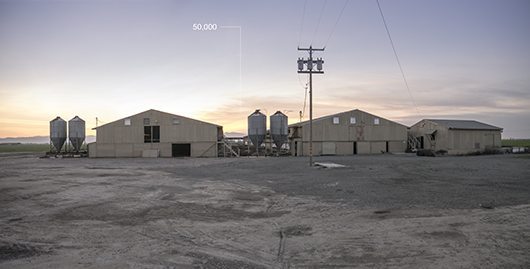
A&L POULTRY, ABANDONED BATTERY CAGE FACILITY, 2013. From the series TESTAMENT, All Rights Reserved Isabella La Rocca.
III. EGGS
THE BELIEF THAT HENS NATURALLY produce eggs for human consumption is absurd. A wild chicken produces only 10-15 eggs per year. A domesticated hen, however, has been bred to produce hundreds of eggs during her most fertile years, which causes osteoporosis and accompanying broken bones, and reproductive disorders (tumors, egg binding, peritonitis, etc.). To stimulate maximum egg laying, artificial light is alternated with periods of darkness. She will likely be starved for extended periods until she loses 25% to 35% of her body weight, also to stimulate increased egg production. Standard industry practices include debeaking,[5] intensive confinement,[6] and gassing or slaughter when the hen no longer produces enough eggs to be profitable, at one to two years of age, much younger than her natural life span. The suffering a hen used for her eggs endures is almost unimaginable.
Similarly, a female fish suffers great pain and stress when her eggs are surgically extracted for caviar. This method has become popular in industrial caviar farms to enable continued exploitation of the female fish for up to ten years. Another method is to extract her ovaries, thereby causing her a painful death.
IV. DAIRY
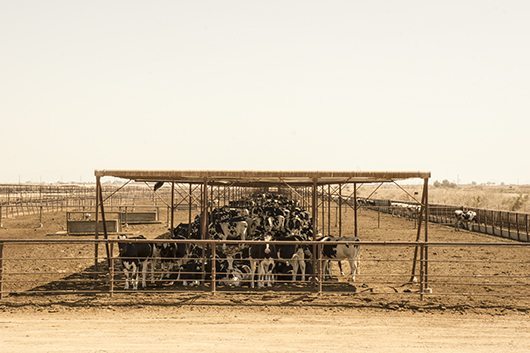
DAIRY COW FEEDLOT 116 DEGREES FAHRENHEIT, 2015. From the series TESTAMENT All Rights Reserved Isabella La Rocca.
A CALF IN THE DAIRY INDUSTRY typically spends the first 2-3 months of life isolated in a small stall. As soon as she is old enough to become pregnant she is artificially inseminated – among dairy industry workers, the colloquial term used for the enclosure used to restrain her during this process is ‘rape rack.’ Her calf is taken from her within hours after birth so that her milk can be sold for human consumption, causing great distress to both mother and baby. Mastitis is common in the dairy industry. When a cow no longer produces enough milk to be profitable, she is sent to slaughter – typically, when she is only 4 to 5 years old. Her natural life span is 25 years.
V. MEAT
ARTIFICIAL INSEMINATION IS ALSO standard practice in the pork industry. For most of her adult life, a sow is kept in a metal enclosure, known as a gestation crate, so small that she cannot turn around. She will chew on the metal bars, wave her head incessantly, and exhibit other signs of insanity. The metal farrowing crate in which she and her piglets are kept while she is lactating is also not large enough for her to turn around. Then her piglets are taken from her and she is again artificially impregnated.
VI. IS ANIMAL AGRICULTURE NECESSARY?
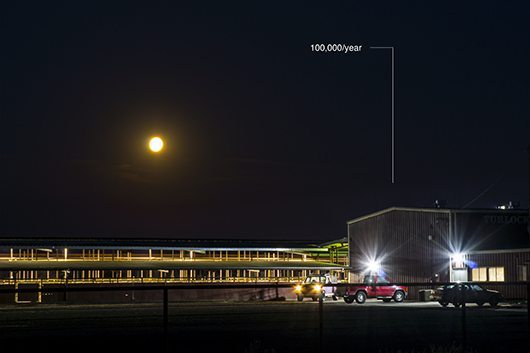
LIVESTOCK AUCTION NIGHT OF THE BLUE MOON, 2014. From the series TESTAMENT. All Rights Reserved Isabella La Rocca.
GROWING CROPS TO FEED ANIMALS to feed humans is grossly inefficient. Seventy percent of crops grown in the U.S. are fed to livestock.[7] Crops raised to feed livestock consume 56% of the water used in the United States.[8] Raising animals for human consumption also requires much more land than growing plants.[9] This flagrant waste of precious and diminishing resources is a primary cause of world hunger.
The workers employed by the industry are egregiously exploited and barely paid subsistence wages. They are predominantly people of color who must support families on minimum wage, no benefits, and few hours. Workers are routinely exposed to toxic substances and the rate of illness and injury is among the highest of any industry.[10]
Consider that over 99% of meat (includes fish), dairy, and eggs comes from industrialized animal agriculture.[11] The fantasy that 7 billion humans – estimated to grow to 9 billion by 2050 – can be fed an animal-based diet without economies of scale is ignorant, regressive, and elitist. ‘Small,’ ‘grass-fed,’ ‘family,’ and ‘organic’ animal agriculture is just as speciesist as and in some ways even more environmentally destructive than factory farming.[12]
Finally, human consumption of animal products has been closely linked to obesity, diabetes, heart disease, cancer and other disease. Studies show[13] and millions of vegans can attest that humans thrive when we eat a whole-foods, plant-based diet.
In summary, trillions of female birds, mammals, and fish every year are exploited for their eggs and milk and to breed 60 billion land animals and trillions of sea animals for no other purpose than for human gustatory pleasure, to the great detriment of the environment, humans, and animals.
The enormous number of animals exploited and slaughtered for this industry almost entirely obliterates our ability to empathize with the plight of each individual. Just as in a patriarchal society women are made absent referents, for example in cultural images of sexual violence in which women are objectified, animals are made absent referents when their bodies are commodified.[14] The exploitation of and violence toward women and animals are rooted in the same system of dominance.
The supremacy of the animal consumption industry is predicated on animals as absent referents, hidden from our view and from our consideration, as reflected in my series TESTAMENT.
VII. ECOFEMINISM AND INTERSECTIONALITY
Though much more complicated and worthy of discussion than is possible to explore here, these feminist concepts inspire a holistic view that can bridge the gaps between environmental and social justice movements.
END NOTES
1 Sheakespeare, William. Macbeth Act 5, scene 5, 19-28
‘To-morrow, and to-morrow, and to-morrow,
Creeps in this petty pace from day to day,
To the last syllable of recorded time;
And all our yesterdays have lighted fools
The way to dusty death. Out, out, brief candle!
Life’s but a walking shadow, a poor player,
That struts and frets his hour upon the stage,
And then is heard no more. It is a tale
Told by an idiot, full of sound and fury,
Signifying nothing.’
2 Food and Agriculture Organization of the United Nations (2006) Livestock’s Long Shadow http://www.fao.org/docrep/010/a0701e/a0701e00.HTM;
World Watch Institute (2009) Livestock and Climate Change: What if the key actors in climate change are…cows, pigs, and chickens? http://www.fao.org/docrep/010/a0701e/a0701e00.HTM
3 Francoise D’Eaubonne is often credited with the first use of the term ecofeminism in Le Feminisme ou la Mort (Paris: Pierre Horay, 1974). Although D’Eaubonne’s work was never translated into English, the term spread rapidly across several continents during the 1970s, leading some analysts to speculate that it emerged synchronistically. Ariel Salleh, ‘Staying Alive: Women, Ecology and Development, by Vandana Shiva.’ Hypatia 6 (Spring 1991), 206-14.
4 Kheel, Marti (2008) Nature Ethics An Ecofeminist Perspective. Lanham, MD: Rowman & Littlefield Publishers, Inc.
6 The terms ‘free-range,’ ‘cage-free,’ ‘free-pastured’, and ‘pasture-raised’ are not federally regulated and have no enforceable meaning. Over 95% of hens used for their eggs are kept in intensively confined conditions.
7 Chrispeels, M.J. and Sadava D. E. (1994) Plants, Genes, and Agriculture. Boston, MA: Jones and Bartlett Publishers.
9 Oppenlander, Richard A. (2013) Food Choice and Sustainability: Why Buying Local, Eating Less Meat, and Taking Baby Steps Won’t Work. Minneapolis, MN: Langdon Street.
10 ‘Workplace Safety and Health: Safety in the Meat and Poultry Industry, while Improving, Could Be Further Strengthened.’ US Government Accountability Office. (4/12/13) http://www.gao.gov/new.items/d0596.pdf
11 Farm Forward calculation based on U.S. Department of Agriculture, 2002 Census of Agriculture, June 2004. https://farmforward.com/ending-factory-farming/
12Capper, Judith L. ‘Is the Grass Always Greener? Comparing the Environmental Impact of Conventional, Natural and Grass-Fed Beef Production Systems’ Molecular Diversity Preservation International, 2012. http://www.mdpi.com/2076-2615/2/2/127
13 Campbell, T. C. (2005) The China Study Startling Implications for Diet, Weight Loss and Long-term Health. Dallas, TX: BenBella Books see also http://nutritionfacts.org/
14 Adams, Carol J. (1990) The Sexual Politics of Meat. New York, NY: The Continuum Publishing Company. A discussion of the concept of the absent referent begins on page 42, reprinted here:
Women and Animals: Overlapping but Absent Referents
‘This chapter posits that a structure of overlapping but absent referents links violence against women and animals. Through the structure of the absent referent, patriarchal values become institutionalized. Just as dead bodies are absent from our language about meat, in descriptions of cultural violence women are also often the absent referent.’

